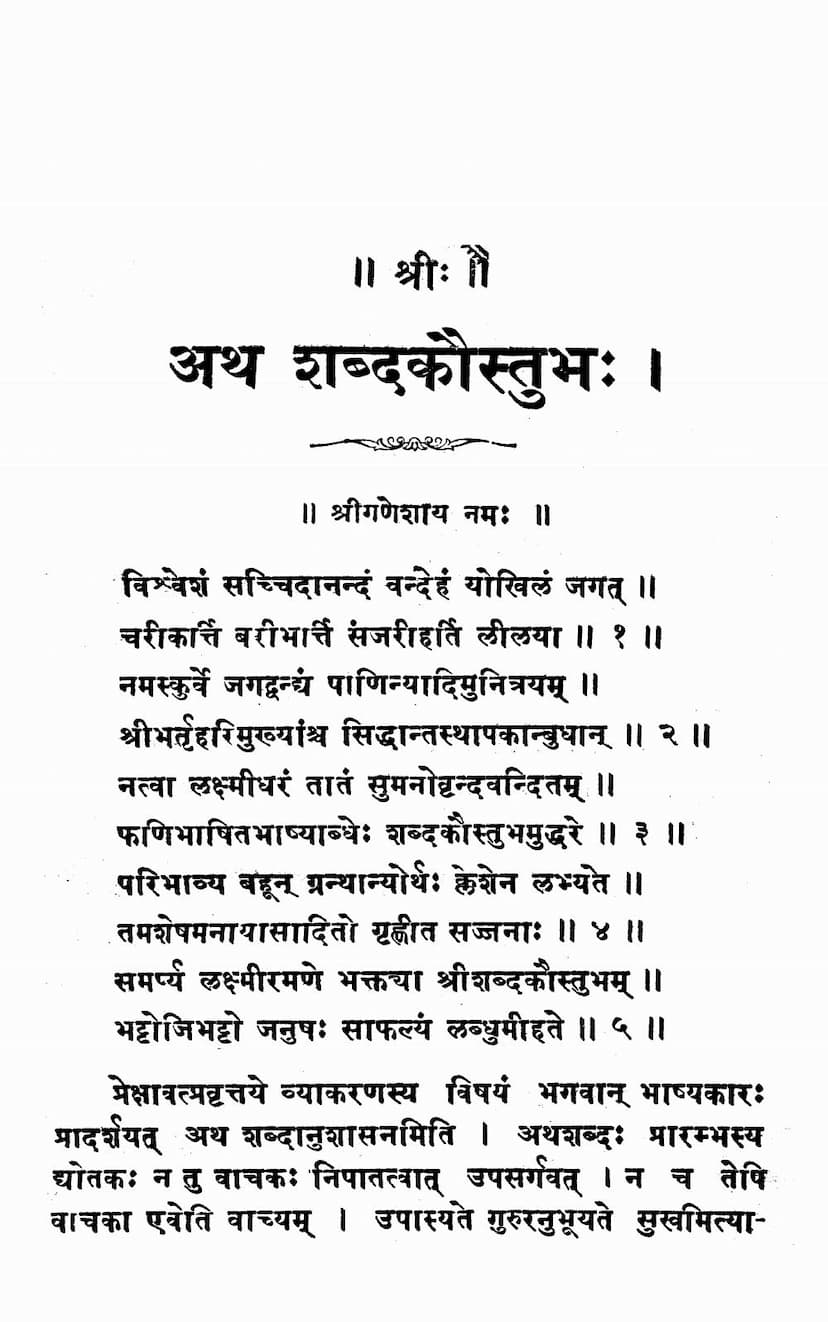Shabda Kaustubh
Added to library: September 2, 2025

Summary
The provided text is the beginning of the Shabda Kaustubh, a commentary on Sanskrit grammar, specifically focusing on the first chapter (Adhyaya) and first section (Pada) of Panini's Ashtadhyayi. It delves into various grammatical concepts and rules according to Jain philosophical interpretations.
Here's a breakdown of the key themes and concepts discussed in the provided pages:
Book and Author:
- Title: Shabda Kaustubh
- Author: Bhattoji Bhatt
- Publisher: Bhattoji Bhatt
- Context: Jain Education International, for private and personal use only.
Invocation and Introduction:
- The text begins with invocations to Lord Vishvesha (Satchidananda) and to the great sages like Panini and Bhatrihari, who established grammatical principles.
- It expresses the author's (Bhattoji Bhatt's) desire to elucidate the essence of Shabda Kaustubh, which is difficult to grasp through other texts, making it accessible to scholars.
- The author dedicates the work to Lakshmi (the Goddess of wealth) and Lord Rama.
Grammatical Concepts Discussed (Early Chapters):
-
Meaning of "Atha" (अथ):
- The text analyzes the word "Atha" at the beginning of grammatical treatises.
- It clarifies that "Atha" is a nipata (particle) and indicates the beginning of an exposition rather than denoting an object. It functions like an upasarga (prefix) in its indicative capacity.
-
Nature of Upasargas (Prefixes) and Nipatās (Particles):
- A significant portion discusses whether prefixes (upasargas) and particles (nipatās) are primarily indicative (dyotaka) or denotative (vachaka).
- The author argues that prefixes are primarily indicative, modifying the meaning of the verb, rather than denotative.
- It contrasts this with particles (nipatās), suggesting that while some may be indicative, others are denotative.
- The text explores various interpretations and arguments regarding the function of prādayaḥ (prefixes like pra, para, etc.) and chādiyaḥ (particles like cha, va, etc.), with the author leaning towards the view that prefixes are indicative and particles are denotative.
-
The Word "Shabda" (Word) and its Nature:
- The text engages in a philosophical discussion about what constitutes a "word" (shabda).
- It questions whether the word itself is the subject of grammatical analysis or if it's the meaning it conveys.
- It touches upon the sphota theory (a concept in Indian linguistics that posits an indivisible sound-unit that unfolds into words and sentences) and discusses various aspects of it:
- Varna-sphota: The idea that individual sounds (letters) are the primary carriers of meaning.
- Pada-sphota: The concept that the word as a unit is the bearer of meaning.
- Vakya-sphota: The notion that the sentence as a whole is the primary unit of meaning.
- Akhanda-sphota: The indivisible aspect of meaning conveyed by sound.
- Jati-sphota: The idea that the universal essence or genus (jati) is the ultimate source of meaning.
- The author explores the relationship between the word and its meaning, the concept of shakti (power or inherent capacity of a word to convey meaning), and how modifications (like prefixes) affect this capacity.
-
The Purpose of Grammar:
- The text examines the "purpose" (prayojana) of studying grammar, citing the traditional explanations from the Mahābhāṣya (Patanjali's great commentary):
- Raksha (रक्ष): Protection of the Vedas from corruption (e.g., correct pronunciation, understanding grammatical anomalies in Vedic texts).
- Ugama (आगम): Correct derivation of words.
- Laghu (लघु): Brevity and efficiency in learning.
- Asandeha (असंदेह): Clarity and removal of doubt in meaning.
- It connects the study of grammar to the broader goal of understanding Vedic literature and performing religious duties correctly.
- The text examines the "purpose" (prayojana) of studying grammar, citing the traditional explanations from the Mahābhāṣya (Patanjali's great commentary):
-
The Concept of "Sadhu Shabda" (Correct Word):
- The text discusses the criteria for a word to be considered "correct" (sadhu). This involves discussing its adherence to grammatical rules, its usage by the learned (shishta), and its etymological basis (vyutpatti).
- It contrasts sadhu words with asadhu words (apashabda) and explores the reasons for incorrect usage.
-
The Beginning of the Ashtadhyayi:
- The text analyzes the initial sutras of Panini's Ashtadhyayi, such as the Maheshwara Sutras (अइउण्, etc.), and their role in deriving various phonetic and grammatical rules.
- It discusses concepts like pratyahara (the compression of sounds into a representative syllable) and the nature of vowels and consonants.
Jain Context: While the text is presented as a Jain text from Jain Education International, the initial pages provided focus heavily on classical Sanskrit grammatical concepts as expounded by Panini and his commentators like Bhattoji Dikshita (the likely author of Shabda Kaustubh, though the text attributes it to "Bhattoji Bhatt" multiple times, which might indicate a specific Jain lineage or simply an emphasis on the Bhatt family). The core grammatical principles discussed are universal in Sanskrit linguistics, but the Jain affiliation suggests a potential for later sections or commentary to incorporate Jain philosophical or ethical perspectives on language, truth, and meaning.
In summary, the initial pages of Shabda Kaustubh, as presented, serve as an introduction to the vast field of Sanskrit grammar from a Jain perspective, focusing on the fundamental nature of words, the role of grammar, and the analysis of initial Paninian sutras, particularly concerning prefixes, particles, and the concept of the word itself.